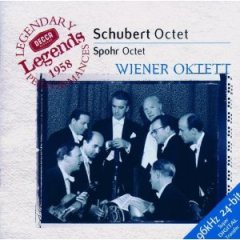Louis Spohr - Octet in E major, op. 32 (2000)
Louis Spohr - Octet in E major, op. 32 (2000)

[1] I. Adagio - Allegro 6:22 [2] II. Menuetto: Allegro 5:21 [3] III. Andante con variazioni: Thema di Händel 7:25 [4] IV. Finale: Allegretto 5:48 Wiener Oktett Willi Boskovsky violin - Günther Breitenbach viola I Philipp Matheis viola II - Nikolaus Hübner cello Johann Krump double bass - Alfred Boskovsky clarinet Josef Veleba horn I - Otto Nitsch horn II Recorded: March 1959, Sofiensaal, Vienna
The Octet, with its unusual but richly sonorous ensemble, has an almost orchestral range of tone colors. A slow introduction, somber but brief, previews both of the opening movement’s important themes: a wide-interval but smooth motive and a dotted-rhythm, neighboring-tone figure. The tonality brightens for the main theme, which is introduced by the horn and echoed by clarinet and violin. The violin is assigned some brilliant passagework in the transition to the subsidiary subject (Spohr did not deny himself the chance to show off his gifts as a performer in this composition), in which the dotted-rhythm figure is given melodic interest. The development section is not long but includes references to all of the thematic materials. A full recapitulation and a coda built on the main theme round out the movement. Though Spohr called the second movement Menuetto, this is really a scherzo, with a wistful, elfin quality familiar from similar pieces by Felix Mendelssohn (who turned five in Berlin in 1814, the year of this Octet); the mellow central trio is led by the horns. The work’s third movement is a set of variations on the well-known theme from Hande’s Harpsichord Suite No. 5 in E Major, popularly known as the Harmonious Blacksmith. “According to the wish of Herr von Tost, who was then contemplating a journey to England,” Spohr explained, “I took up a theme from Handel, varied and carried it out thematically, as he was of the opinion that it would on that account excite great interest in that country.” The movement works upon Handel’s procession-like theme with six variations that allow both variety of mood and virtuosity of execution. The finale is a spacious rondo built on a genial melody of folkish character. --- Dr. Richard E. Rodda, encoreccm.org
download: uploaded yandex 4shared mediafire solidfiles mega zalivalka anonfiles filescloudio oboom
